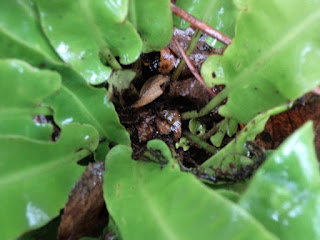In the middle of this continuously wet November with the storms of recent days, it is easy to look out on my back garden and see only death and decay.
In spite of my attempts to lift them regularly, the leaves have fallen so heavily that path ahead can seem unclear. The other day I was out lifting some of them and it was a cold and, frankly, miserable job. No sooner had I lifted them and more came down.
I looked about me and the garden seemed desolate.
My Sycamore,
Acer pseudoplatinus, has been stripped of most of leaves.
My neighbour's
Acer which usually cast such a dense shadow over the back of my back garden is practically bare already.
In such times, when everything seems to be dying, it is tempting to run for the cosy comfort of home.
Shut out the world - retreat into hibernation, thinking no one can harm me so long as I just keep my head down. And if I never look out I have no need to know how bleak the winter world has become.
As I have said before, there are indeed people who would be happy for me to do that for they want this world to themselves. They want to convince me that this is a vile, corrupt existence that only they can liberate me from - usually by killing me, chopping bits off me, or trying to get me to hate myself. They call this godliness.
But my back garden seems to have a different kind of Godliness, for when I look at it closely I see no death or vileness or corruption.
On a pile of rotting vegetation behind the shed I see the fruiting bodies of fungi - bodies that are only a tiny hint of the vastly intricate lacework of life that has produced them.
Did you know the largest life form on earth is a fungus?
Don't take my word for it - look it up and be amazed.
The leaves have only just disappeared from the Rowan,
Sorbus aucuparia, in the last few days and yet, already, the furry buds for next year's leaves are perfectly formed.
The little Irish Yew (
Taxus baccata 'Fastigiata') I planted a couple of years ago has had its first baby berries this autumn. What joy, because Yews are usually male or female but I did not know the sex of this one until now.
The oldest Yew in Scotland is male and is over 3000 years old. This summer it has started producing berries, for, indeed, ancient Yews can change their sex.
Will God punish it for its transgender transgressions? It grows in a churchyard too!
Fuchsia 'Brutus' is also producing berries and is still flowering in the midst of all this cold, wind and rain.
But then, originating from the foothills of the Andes maybe it is well used to dealing with the odd storm.
There is still vibrant colour on the remaining leaves of the Blueberry too,
Vaccinium corymbosum 'Patriot'.
Meanwhile, down on the ground amidst the fallen leaves, the foliage of next year's self-seeded floriferous wonders have formed rosettes that will provide a sure foundation: Foxglove (
Digitalis purpurea); Columbine (
Aquilegia vulgaris) and Feverfew (
Tanacetum parthenium).
Also appreciating some cover from autumn leaves is the Hart's Tongue Fern,
Asplenium scolopendrium. Looking into its heart, here, you may be able to make out amongst the mould the beginnings of next year's fronds. Ferns arrived on this planet before flowers and are around 400 million years old.
Continents, vast numbers of species of life, and even BBC TV's "Last of the Summer Wine" have come and gone in that time.
Still the rain falls and in my back garden I try to collect some from the roof of my shed - I think I need a few more buckets.
The netting is not to stop anyone getting water - it is purely to prevent young birds in the spring from falling in and drowning.
Yes, it can be a dangerous world out there sometimes.
But dangerous or not, my back garden just gets on with life. In darkest December and January this flower bud will open and spread an almost intoxicating scent around the garden. This is
Viburnum x bodnantense and is a winter star.
Believe what you wish. Kill who you wish if you must.
The God that lives in my back garden kills no one and no thing. Even in the darkest of days, this God puts out a bright, perfumed light of life.
And I shall do whatever it takes to ensure I never lose sight of that light: the light that no human being, however loud or bloody, can ever extinguish.
(For some reason I am unable to post the video I want, which is Sinead Lohan singing 'Whatever it takes.' So, the link to it is below)
Whatever it takes
























































